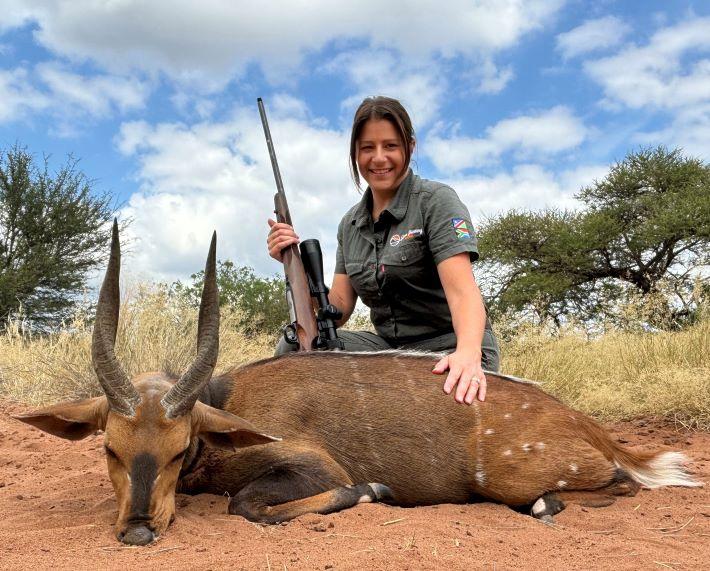I had the opportunity to go on a bushbuck hunt in Limpopo and what an awesome experience it was.
We traveled from Johannesburg to Limpopo, if you land at OR Tambo international you will take the same route. We traveled along the N1 highway, this road is safe and well maintained. You will pass through several toll gates on your way to your destination and there is usually no major hold up, however if you are travelling on a public holiday the traffic tends to get very busy and there may be some delays so its best to keep this in mind and try to avoid travelling on these days, but if its unavoidable then try to get on the road as early as possible to miss most of it.
On the way you will be able to stop at gas stations along the highway. These gas stations are fully equipped with fast food outlets, a convenience store, ATM’s and restrooms. It is advisable to use the ATM’s here and withdraw some local currency (not a huge amount as walking around with wads of cash is not the best idea). The fast food outlets include burgers, pizza, fried chicken (very popular) and of course some really good coffee (especially important if you are travelling early in the morning ).
[DYNAMIC-BLOGTABLEOFCONTENT]
The convenience store will also stock basic supplies like antacid, feminine hygiene products, headache tablets and plasters. There is also a great stock and variety of cigarette brands (if you smoke).
The restrooms are clean and well maintained and this is the ideal stop to stretch your legs and stock up on any items you may have forgotten or just to grab some snacks for the drive, as we were travelling far north into Limpopo our drive took us 5hours (depending on where in Limpopo you area travelling to this could take as little as 2hrs). We stocked up on biltong, a South Africa favorite, it is similar to jerky but 100 times better. Biltong can be made from any game meat or beef and has 3 varieties, wet, moist and dry. This refers to the time that it has had to dry. Wet biltong is the best and the most flavor filled, however it is really personal preference.

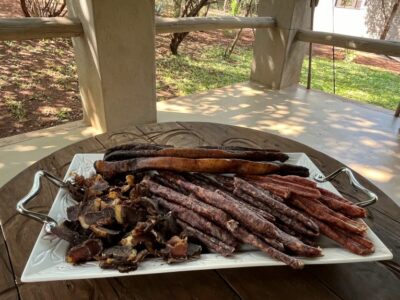
We passed the Tropic of Capricorn. The Tropic of Capricorn is the most southern latitude on the Earth where the sun can appear directly overhead. The Tropic of Cancer is currently positioned at approximately 23.4 degrees north of the Equator. The Tropic of Capricorn is 23.4 degrees south of the Equator. We continued travelling, watching the vegetation change along the way from bushveld to more lush forest like vegetation, where Bushbuck are likely to be found.
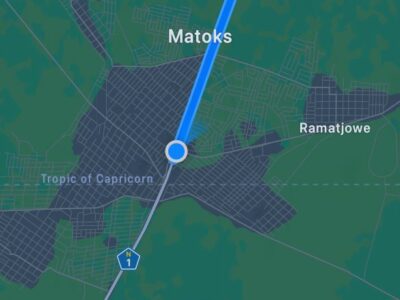
Types of Bushbuck
The Harnessed Bushbuck or Northern Bushbuck (Tragelaphus scriptus) and the Cape Bushbuck (Tragelaphus sylvaticus).
The Harnessed or Northern Bushbuck is smaller than the Cape Bushbuck it is a medium-sized antelope, widespread in sub-Saharan-Africa. A Close relative of the Kudu and Nyala, the bushbuck is an antelope which relies on vegetation for cover. The harnessed bushbuck has the most prominent markings on its body and has a clear horizontal line, as well as spots and vertical stripes.
The Cape bushbuck is the most studied species and is found from the Cape in South Africa up to Angola in the west and up through the east side of the continent towards Ethiopia and Somalia. is a lot more varied in coloration throughout its range. Only the genetically oldest populations of Cape bushbuck have clear markings, but none have the distinct horizontal line which is instead broken up into spots. Some Cape bushbuck populations have almost no markings
Bushbuck are the least social of the African antelopes. They are often seen singly, although sometimes small groups of females and their respective young are found. Bushbuck are not territorial, and except for disputes over females in estrus they are not aggressive toward one another, so in areas with good quality habitat there may be several animals in close proximity. Therefore the traditional designation of them as “solitary” is somewhat misleading. These antelope are mainly nocturnal, although they may also be active at dusk and/or dawn. The daytime is spent concealed from predators (which include virtually all carnivores their size or larger) in dense, bushy cover of the type that is usually found near rivers. Bushbuck are found in dense bush at the base of mountains or along river courses, but always close to a permanent water supply.
They come out at night to feed in more open areas, but never venture far from some type of cover. Bushbuck are very capable swimmers.
Did you know? The very sharp horns render the Bushbuck very dangerous when wounded.
Bushbuck will live anywhere from sea level to mountain-tops in all types of habitats from forest to sub desert terrain. The color varies depending on geographic location. Northern and western bushbuck are reddish colored with stripes and spots. Both sexes darken with age.
Males weigh 40-80 kg and stand 70-100 cm tall.
Females weigh 25-60 kg and stand 65-85 cm tall.
Horns are nearly straight with one twist close to the bottom, 26-57 cm long.
Browsers, bushbuck eat leaves and herbs, twigs and flowers of a large number of plant types. On occasion they will also consume grass.
The bushbuck is primarily nocturnal, but it is also fairly active during the day. Most of the day is spent standing, grazing and feeding and a small amount of time is spent moving about. At dusk bushbuck move toward their night range. Before dawn all bushbuck move back to their day range.
Did you know? When alarmed, individuals react in a variety of ways. If they are in forest or thick bush, they may freeze in one position and remain very still, allowing their coloring to camouflage them. The bushbuck is the only non-territorial and solitary African antelope. Neither males nor the females defend any part of their territory so many territories overlap. So I had my work cut out for me. Bushbuck hunting is not easy and these animals can be very elusive and are very skittish especially if they feel threatened.
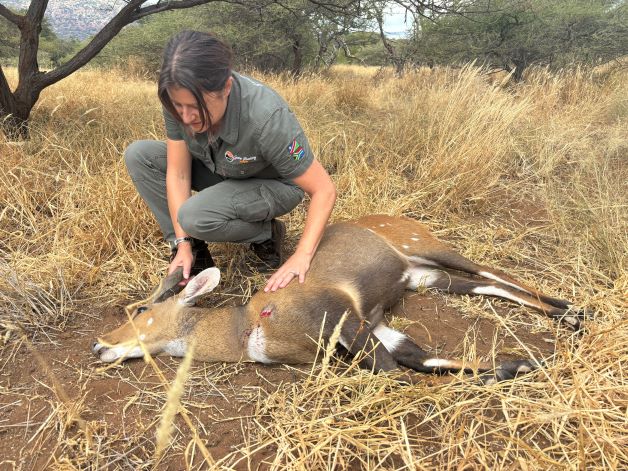
How do you hunt a Bushbuck?
On foot, walking and stalking as quietly as possible because as soon as a Bushbuck sees or hears you he is off at a run. One also has to be conscious of the wind as these antelope have a very well developed sense of smell, so we had to walk downwind to prevent him smelling us. Baboons are a nuisance, we came across some of them while stalking a big bull Bushbuck. The baboons saw us first and started running and shouting, spooking off the Bushbuck bull and we had to start all over again.
What type of sounds do Bushbuck make?
The bushbuck barks. They also make a variety of different sounds and calls that are used for communication within their social groups. The bark, which is made by both males and females, is a distinctive, powerful, resonant sound that can travel a considerable distance. It acts as a warning signal to other members of the group of potential risks or the presence of predators.
Bushbucks may emit short, sharp snorts as an extra warning signal when disturbed or startled. Males generate a succession of grunts and groans as part of their wooing display throughout the mating season. These vocalizations are used to attract females and establish dominance over other males in the vicinity.
On the track of the Bushbuck
So we were back on the track of my Bushbuck and I nearly died… ok perhaps a bit of an exaggeration… I had a close call with a Golden Orb spider, it was head / face height and I almost waked straight into it. It was eating a butterfly which I saw just before I walked into it. I know, big game hunter and I am still unsettled by spiders but it is what it is and I don’t pretend not to be scared of some of the little (and not so little) critters.
The Bushbuck seemed to be aware of us and was hyper alert after already being spooked by the baboons so we tread as quietly and as quickly as possible. My PH spotted him running and threw out the sticks, my heart started pumping as I positioned the rifle on the shooting sticks, only to find that there was a rather large tree blocking my perfect shot.
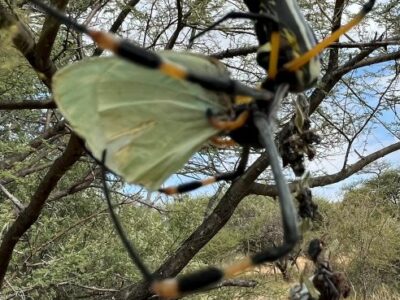
What type of rifle is best for Bushbuck Hunting?
I am biased and love my 300 win mag and with this caliber you can shoot almost anything with it. However a 7mm or any 30 caliber rifle will do the trick nicely loaded with 180 grain bullets.
Shot Placement on a Bushbuck
Shot placement on a Bushbuck is the same as any other medium sized antelope and although you have a few options I don’t like taking any type of head shot as they are far too risky and if you get it even slightly wrong you potentially wound an animal that will suffer for an inordinate amount of time before it dies as a misplaced head shot wont kill the animal. I am also not a fan of the “Texas heart shot” my go to is always a third of the way up on the body, that way if you are even slightly off you potentially hit and break the leg and invariably hit the lungs or a piece of the heart. The third of the way up on the body following the front leg, is always a good bet.
The Bushbuck Hunt continues..
I am off again stalking my Bushbuck, after baboons and trees I was determined that I would not loose track of this Bushbuck. So we are tracking again, find him and set up sticks, he jumps up and runs. Thankfully not far and stops with his head down, I can see him in the scope and I’m all ready to go.
I’ve mentioned my reluctance to take a “Texas Heart Shot” and Murphy’s law when I finally get the bushbuck in my sights what option is presented….. yes, he was standing facing away. At this point it is very useful to have an experienced PH who is quietly talking to you as he is also looking through the bino’s. John says quietly to me “you see him?” I say yes but his head is down and I can only see his butt, John says wait… wait… he will lift his head ( a good PH is familiar with animals behavior and can, for the most part predict an animals next move) and next moment my Bushbuck lifts his head and is standing in the quartering away position, I can see his shoulder and take the shot.
Now at this point I need to remind you (as I reminded myself) that a wounded or cornered Bushbuck is actually quite a nasty animal. It will get aggressive and vindictive, in that it will hide in the thick bushes and wait for you to be in the perfect position and charge at you. The spiral horns of the Bushbuck make this a very dangerous animal when charging at you and because of their height they will often hit the femoral artery without immediate intervention, a person can bleed out from the femoral artery in as little as 2 minutes. On average, the bleed-out time varies between 2 and 5 minutes. This is because Certain arteries are especially vulnerable to rapid bleed-outs. An injury to the femoral or carotid artery can be especially dangerous because these are the main blood vessels responsible for pulling oxygen-rich blood from the heart to the rest of the body. I personally think that the dangerous seven could possibly be revised to include this beauty but because it is relatively small with medium horns it doesn’t make it.
I took the shot and it was nicely placed on the shoulder, the 300 went right through nicked the heart and exited on the front left of the Bushbuck. He went down without any trouble. But still I was very cautious when approaching him.
Speaking of other dangerous critters it is worthwhile having a read on our blog page about dangerous critters, some of these include the scorpion and mosquito (which seems unlikely but actually cause more deaths than the top five put together.
T. van Wyk
